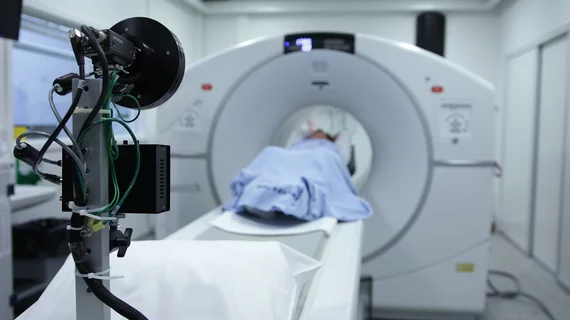US Imaging experts cast further doubts about CT’s place in radiologists’ COVID diagnosis toolkit
As shortages of molecular testing kits continue to plague efforts to control the COVID-19 pandemic, some providers are turning to CT as an alternate diagnosis method. However, a group of U.S. imaging experts are urging against this pivot, according to new research.
Stat News was the latest to explore this conundrum in a high-profile item published Thursday. Researchers out of China, the report noted, have touted computed tomography’s accuracy in diagnosing the disease. But such claims run counter to recommendations from the American College of Radiology, CDC, and Royal College of Radiology.
A group of a 11 U.S. imaging experts are the latest to join this group, publishing their reservations April 16 in the American Journal of Roentgenology. Combing through previous retrospective reviews and case studies on CT’s use as a front-line diagnostic tool, the authors deemed them “low quality,” and urged against this use of the modality.
“To date, the radiology literature on COVID-19 has consisted of limited retrospective studies that do not substantiate the use of CT as a diagnostic test for COVID-19,” concluded lead author Constantine Raptis, MD, with Washington University’s School of Medicine in Saint Louis, and co-authors from several other institutions across the country.
“At present, CT should be reserved for evaluation of complications of COVID-19 pneumonia or for assessment if alternative diagnoses are suspected,” they added later. “As the medical community gains experience in treating patients with COVID-19 pneumonia, high-quality data hopefully will emerge and will support a more expanded role for CT. We (and the radiology community at large) will welcome any such data to improve the care of patients with this disease.”
In backing their claims, Raptis and colleagues expressed doubts about CT’s sensitivity and specificity in pinpointing the disease. On the latter, the team acknowledged that reverse transcription-polymerase chain reaction tests can produce false positives. However, such results are often caused by contamination, and “are likely insignificant in the setting of assays for COVID-19,” they wrote. CT, meanwhile, does not test for singular features unique to the disease, with many COVID-19 pneumonia findings also overlapping with similar indications for other conditions.
Raptis also outlined challenges deployment CT as a first-line diagnostic tool, given cleanup concerns that would make systems unavailable for other patients.
“No diagnostic test is without risks, and the hazards of wide deployment of CT must be acknowledged,” they wrote. “These risks include: overuse of hospital resources, including the use of protective gear that is already limited in availability but is required to safely perform CT studies; clustering of affected and nonaffected patients in imaging departments, thereby potentially increasing risks of disease transmission and exposure among staff performing the examinations; patients for other indications because of increased use of CT scanners to evaluate cases of suspected COVID-19.”
You can read the entire AJR study for free here, and the report from Stat News here.

